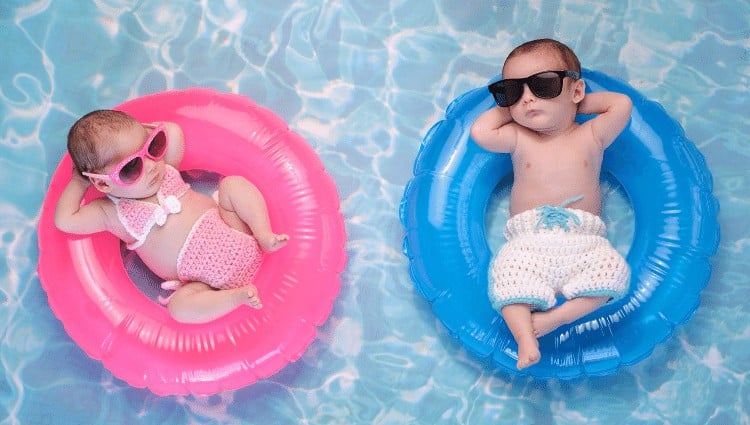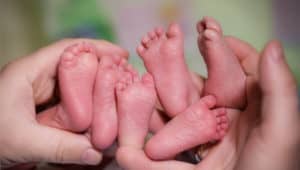-
Author: Khushboo Kirale
- >> Post Created: September 15, 2020
- >> Last Updated: April 27, 2024
Medically Reviewed by: Dr. Veena Shinde (M.D, D.G.O, PG – Assisted Reproductive Technology (ART) from Warick, UK) Mumbai, India

Table of Contents
As a parent of triplets, who are of the same gender, I have been asked this question a gazillion times, “Are they identical or fraternal?” Even though my boys do look similar but they are not identical in appearance. Most people who ask this question are mainly asking about the appearance, i.e., whether the babies look identical or not.
But these terms, identical and fraternal, are not based on their appearance but in the manner the babies were conceived.
Identical vs. Fraternal twins: What’s the Difference?
When you use the term “identical twins,” you are mainly asking the question whether the babies are “monozygotic twins.”
‘Mono-’ means one or single, and ‘-zygotic’ means zygote, which is a fertilized egg. So basically monozygotic would mean ‘from a single fertilized egg.’
So, when a single fertilized egg splits into two, due to some unknown biological mystery, the two resulting eggs will contain the same genetic components and will result in two babies who are genetically extremely similar. These babies are called monozygotic twins or more commonly identical twins.
On the other hand, “fraternal twins” are mainly “dizygotic twins.” From the nomenclature we can easily spot the difference that identical twins have ‘mono-,’ which means one or single, and fraternal twins have ‘di-,’ which mean two or double.
So, if monozygotic means ‘from a single fertilized egg,’ then dizygotic means ‘from two fertilized eggs.’
In fraternal twins, the mother releases two eggs, which are then fertilized by two different sperms. This results in twins who are genetically different from each other and can look as similar or different as any two siblings.
How is a Baby’s Gender Determined?
Humans are born with 23 pairs of chromosomes. One of these 23 pairs is the sex chromosome. The sex chromosomes will determine whether the baby will have male or female reproductive organs.
Females are identified with the presence of the XX chromosome and males with the XY chromosome.
When a woman releases an egg it will contain any one of her X chromosomes. But when a man releases sperms, each sperms will contain either the X or the Y chromosome. Therefore, during fertilization, a female can contribute only one X chromosome, the gender of the baby will be determined based the sperm that fertilizes the egg.
If the sperm contained the X chromosome, the child born will be female with one X chromosome from the mother and the other from the father; whereas if the sperm contained the Y chromosome, the child born will be male with the X chromosome from the mother and the Y chromosome from the father.
Please Note: We are only talking about gender in terms of the reproductive organs a baby is born with and not about their gender identity, expression, etc., which may be different from the gender assigned to them on birth.
Read this next
What are the Gender Variations in Identical and Fraternal Twins?

Based on the above concept of gender determination, we can now understand the different gender variations in identical and fraternal twins.
For identical twins:
As identical twins grow from a single fertilized egg that later split to form two zygotes with the same genetic material, the gender of both the babies will be the same. That means they can either be both females or both males. Let us look at each scenario in detail.
Scenario 1, both girls: The egg that always contains the X chromosome from the female is fertilized by a sperm containing the X chromosome from the male. So the resulting zygote formed will have the XX chromosome, which develops into a baby girl. Now the egg splits in two and the both the resulting embryos will still contain the same genetic material and, therefore, the same sex. So both the babies will be females.
Scenario 2, both boys: Similar to both females scenario above, if the egg containing the X chromosome from the female is fertilized by the sperm containing the Y chromosome from the male, the resulting zygote will contain the XY chromosome, which develops into a baby boy. After the egg splits, the two embryos will have the XY chromosome and will both be males.
For fraternal twins:
Fraternal twins are dizygotic twins, where two eggs are released by the female which are fertilized by two different sperms from the male. The gender variations in such a case can be of three types which is represented in the table below.
Scenario 1 | Scenario 2 | Scenario 3 | |
Egg 1 | XX | XY | XX |
Egg 2 | XX | XY | XY |
| Both girls | Both boys | One girl and one boy |
Let us look at each scenario separately.
Scenario 1, both girls: The two eggs released by the female contain one X chromosome each. Now each of these eggs is fertilized by two different sperms. In this scenario, both the sperms contain X chromosome from the male. The two zygotes will each contain XX chromosomes and will develop into two baby girls.
Scenario 2, both boys: The two eggs released by the female contain one X chromosome each. Now each of these eggs is fertilized by two different sperms. In this scenario, both the sperms contain Y chromosome from the male. The two zygotes will each contain XY chromosomes and will develop into two baby boys.
Scenario 3, one girl and one boy: The two eggs released by the female contain one X chromosome each. Now each of these eggs is fertilized by two different sperms. In this scenario, one of the eggs is fertilized by a sperm containing the X chromosome and the other egg is fertilized by a sperm containing the Y chromosome. So one of the zygotes will have the XX chromosome and will develop into a baby girl, and the other zygote will have the XY chromosome that will develop into a baby boy.
From this section we can easily see that identical twins always have the same gender, whereas fraternal twins can be of the same or different gender. But off course, there are always exceptions to the rule.
Can Identical Twins Sex be Different?

Identical twins predominantly have the same sex. But, there have been extremely rare instances where the monozygotic twins are of different sexes. This scenario is so rare that there have been only a few reported cases so far and it is unlikely that you will come across such twins in your lifetime.
Let us now look at the ways in which monozygotic twins can be of different sexes:
Scenario 1: In this case, an egg containing the X chromosome is fertilized by a sperm containing the Y chromosome. The embryo thus formed will have the XY chromosome. Now the egg splits.
Ideally the egg should split to result in two embryos, each having the XY chromosome. But due to some inaccurate copying of the chromosomes, only one zygote has the XY chromosome and the other will not have the Y chromosome from the father and will result in XO chromosome.
The embryo containing the XY chromosome will develop into a male, whereas the embryo containing the XO chromosome will develop into a female.
This condition of having only one X chromosome is called Turner Syndrome and can result in short stature, lack of ovarian development, etc. The male twin will be unaffected and will develop normally.
Scenario 2: In the above scenario we saw a chromosome copying error that resulted in one sex chromosome being eliminated. But sometimes this copying error can also result in an extra sex chromosome to be added.
An egg containing the X chromosome is fertilized by a sperm containing the Y chromosome. The resulting zygote will have the XY chromosome. The embryo then splits to form two separate zygotes.
One of the zygotes will have the same XY chromosome, but the other zygote will have an extra X chromosome due to the copying error resulting in a zygote containing the XXY chromosome.
Further glitches result in the zygote eliminating the Y chromosome resulting in a zygote with XX chromosome. So the embryo containing the XY chromosome will develop into a boy and the embryo containing the XX chromosome will develop into a girl.
Scenario 3: There is a twin type called the polar body twins or half-identical twins.
In this case the egg splits before fertilization and each egg is then fertilized by a different sperm. If one egg was fertilized by a sperm containing the X chromosome and the other egg was fertilized by a sperm containing the Y chromosome, then this would result in twins having different sexes.
As these twins contain the same genetic material from the female and different genetic material from the male, they are called half-identical twins.
Till date, the concept of polar body twins is only there in theory and there is no definitive test that can confirm whether the twins are polar body twins.
Scenario 4: Another twin type is semi-identical twins or sesquizygotic twins. This twin type is extremely rare.
In this case what happens is a single egg is fertilized by two sperms. The zygote then splits to create semi-identical twins. If one of the sperms contained the X chromosome and the other the Y chromosome, the resulting twins will be of different sexes.
In 2019, a boy-girl semi-identical twins were identified in Australia. They were identified as sesquizygotic because they shared a placenta, which is only seen in identical twins, but had different genders, which is only seen in fraternal twins.
Semi-identical twins are different from polar body twins because in semi-identical twins the egg splits after fertilization, whereas in polar body twins the egg splits before fertilization.
Final Thoughts
Although there are reported cases of monozygotic twins or commonly known as identical twins to be of different sexes, there cases are extremely rare.
It is safe to assume that if twins born are of different sexes, 99.99% of the time they are going to be dizygotic or fraternal twins and not identical twins.










Hello, i think that i saw you visited my website so i came to “return the favor”.Im trying to find things to enhance my website!I suppose its ok to use a few of your ideas!!
Resources like the one you mentioned here will be very useful to me! I will post a link to this page on my blog. I am sure my visitors will find that very useful.
Thanks
Great Share! Aw, this was a really nice post. In idea I would like to put in writing like this additionally – taking time and actual effort to make a very good article but what can I say I procrastinate alot and by no means seem to get something done.
Thanks you dear
Very good written story. It will be beneficial to anyone who utilizes it, as well as me. Keep up the good work looking forward to more posts.
Thanks
Hi! I found your website by accident this morning, but am really pleased that I did! Not only is it entertaining, but also straightforward to use compared with lots that I’ve viewed! I was attempting to discover what theme you had employed, – anyone have any clue? I’ve utilized a similar overall page layout myself, but discover that your web site loads a lot more swiftly, although you seem to have a great deal additional material. The only issue I’ve had is with the header, which seems less wide that the actual page in Opera v8.0, although it appears OK in IE and in firefox maybe it’s time to swap! Excellent web site, incredibly tidy job, and a excellent inspiration for my simple attempt! I’ll be looking to improve my own internet site and will certainly visit again soon!
Thanks.
I think this is a real great blog post.Really looking forward to read more. Great.
Nice information on the topic. Well written and well researched. Keep up the good work.
Fairly insightful publish. Never thought that it was this simple after all. I had spent a very good deal of my time looking for someone to explain this topic clearly and you’re the only 1 that ever did that. Kudos to you! Keep it up
Thanks Aria. Your words are encouraging.
Well written. I liked the way you have explained it in simple language.
All the best!
Hello 🙂 nice work. I bookmarked this site. Thanks heaps for this!…
Thank you for an additional good write-up. Where else could anybody get that kind of information and facts in these a ideal way of writing? I have a presentation subsequent week, and I am to the appear for this kind of facts.
Spot on with this write-up on unique identical twins with different genders, I really assume this web site wants rather more consideration. I’ll probably be again to learn much more, thanks for that info.
Definitely, what a great site and revealing posts, I will bookmark your site.All the Best!
Thank you
I am a twin myself and I am really impressed with your writing. You wrote it so nicely with considerable class. Brilliant one, man! Very fantastic things right here.
Excellent. Complicated information simplified.
Hey there, solid blog website and layout. I am hoping I am not annoying you I merely wanted to inquire precisely what wordpress plugin you use to show the newest commentary on your blog? I want to do exactly the same for my free apple iphone page but I cant find the plugin or widget for it. Thanks for your time
Its best to participate in a contest for probably the greatest blogs on the web. I will advocate this website!
Thanks Penelope
Well written! keep up the good work.
I have a friend whose son had twins. They were same sex male at birth BUT at age 5 one child has decided “she” is in fact a girl and so the parents are treating her as that and sending them to kindergarten as separate genders. Do you think in these unusual gender times this might become more common or is it already somewhat “common”?
Hi Dave, thanks for checking-out our blog.
Its may happen, but personally I don’t think its common. Such cases needs to be handled with utmost sensitivity and if need be parents should take a professional help in terms of how to cope-up with the situation.
Identical Twins with different genders. Such a fun idea. No that I am 5 months pregnant, I wish I had twins 🙂
Very well researched and written.
Keep writing.
Informative article. Well written and researched.
Keep up the good work.
Thanks Chloe.